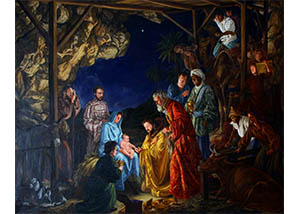They were overjoyed at seeing the star, and on entering the house they saw the child with Mary his mother. They prostrated themselves and did him homage. Then they opened their treasures and offered him gifts of gold, frankincense, and myrrh.
–Matthew 2:11-12–
In the formal dining room of the Cathedral rectory in Allentown, there hangs a beautiful painting entitled The Adoration of the Magi. The work was commissioned in the 1980s by His Excellency, Joseph M. McShea, first Bishop of Allentown, and the artist was a man by the name of Dana Van Horn, who was then living in upstate New York. Most of the human subjects in the painting were Van Horn’s renderings of real-life Cathedral parishioners.
The Adoration of the Magi shows a serene Mary in blue holding a chubby Christ-Child in her lap. Behind Mary, with his hands on her shoulders, stands a vigilant, dark-bearded Saint Joseph with a rather perplexed expression on his face. One of the Magi, who has apparently just offered his gift, kneels before the infant Jesus and gently touches a tiny outstretched hand. His face wears an awe-filled look that says, “I can’t believe this is happening to me!” Immediately behind him stands a gray-bearded Magus, leaning forward and totally transfixed by what he sees. At a slight distance stands the third Wise Man, still holding his gift. His turbaned ebony countenance seems intent on missing nothing.
A closer inspection of the painting reveals that the faces of Mary and Joseph form the left side of an almost perfect “V.” The faces of the three Magi likewise form the opposite side of the “V” so that one’s eye is naturally drawn to the Christ-Child at the bottommost point.
The painting shows additional figures—a crescent-horned ox, some floppy-eared sheep, a shepherd who appears to be half asleep, a camel, atop which sits a white-clad member of the Magi’s retinue. Other members of the retinue include the figure of Dana Van Horn himself leaning in toward the face of the turbaned magus as if about to make a whispered comment. The whole scene takes place in what is obviously a cave, whose rocks bear the hint of human outlines—possibly angels. Through a wooden framework can be glimpsed a palm tree against a night sky, cloudy on the horizon but deep blue and dotted with tiny stars at its zenith. The painting is truly magnificent.
Now the story goes—and I have it on the authority of the artist himself—the story goes that when the masterpiece was unveiled in 1985, Bishop McShea stared at it for a while, turned toward the painter and said, “Where’s the star?”
“The star, Your Excellency?”
“The Star of Bethlehem—where is it?”
“Your excellency,” responded the artist, “I purposely left out the star. Look how the infant Jesus is aglow, as if He were a fire, providing almost all the light in the scene! It is His radiance that is reflected on all the faces. See? I wanted to show that Jesus Christ is the Light of the World. And besides, Your Excellency, if there were a star, it would be directly overhead and thus invisible to us.”
Unmoved by this pious but passionate defense, Allentown’s first prelate made a demand in somewhat colorful language that has echoed among the clergy down through the decades. “That’s all very well and good, Dana, but I WANT A… STAR!”
With a few quick brushstrokes, an exasperated Dana Van Horn reluctantly complied with the episcopal edict. Thus the Star of Bethlehem, as a kind of afterthought, now graces The Adoration of the Magi in the Cathedral dining room.
Bishop McShea’s imperious demand has been the topic of priestly humor for more than thirty years. He was certainly no art critic, but perhaps as a theologian, he was on to something. What was so important about the Star of Bethlehem anyway? Obviously, it led the Magi to Jesus.
Perhaps one vital lesson of the Epiphany is that each one of us, in his own way, is called to be like the Star of Bethlehem to lead others to Christ. To paraphrase the old Bing Crosby song, we could be better than we are. We could be made into a star. Hollywood stars point to themselves. The stars that God wants point to Christ.
I have to ask myself: Am I the kind of person who might possibly lead someone to Jesus? Do I know my Catholic Faith, love it, and live it so as to inspire others to take a more positive look at the Catholic Church? Is what I do at Sunday Mass integral to what I do the rest of the week? In short, am I a knowledgeable, joyful, and credible witness to Jesus?
In the book of Daniel, we read:
But those with insight shall shine brightly like the splendor of the firmament, and those who lead the many to justice shall be like the stars forever.[1]
Is this a prophecy meant to apply only to the afterlife, or could it describe even now the shining example of those who lead others to Jesus? Does it, in fact, describe me at this very moment?
Let’s you and I take a good, hard look at ourselves in the mirror to see how we measure up as witnesses for Christ. If we listen closely, we might hear Our Lord say in no uncertain terms, I WANT A STAR![2]
[1] Daniel 12:3.
[2] Photograph courtesy of Dick Musselman, Cathedral parishioner. Photograph and homily posted with permission of the artist: “Dear Father Ezaki, You are welcome to post the painting on your blog. I think your homily is excellent as is. I wouldn’t change anything. My best, Dana” – January 2017.

